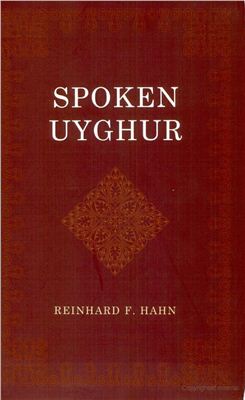Hahn R.F. Spoken Uyghur. - University of Washington, 2006. - 660
p.
Mode Uyghur is an Easte Turkic language. Most of the seven to ten million native speakers of Uyghur live in northweste China, where Uyghur is also the lingua franca of various other ethnic groups. A smaller Uyghur-speaking community is politically and culturally active in Central Asia. As the predominant indigenous language in a crucial area that bridges the frontiers of multiple states, and as a language of great interest to comparative linguists, Uyghur is increasingly important. This book has become one of the standard works on Mode Uyghur, and there is no comparable Weste work on the mode standard language. With this book, both scholars and those who simply want a basic working knowledge gain access to Uyghur as it is spoken today. This book's primary purpose is to teach conversational skills. No familiarity with the structure of Turkic languages is assumed, and the material is appropriate for both self-instruction and classroom use. For those familiar with other Turkic languages, it demonstrates the characteristics specific to Uyghur and provides useful reading practice in Roman- and Arabic-based script. "Spoken Uyghur" also contains an extensive description of the morphophonology and orthography of the language, and fifteen instructional dialogue units, with extensive notes explaining grammar and customs. Of particular value are the Uyghur-English and English-Uyghur indexes and a reference guide to inflectional pattes. Also included is a reinterpretation of previous scholars' contributions to the study of Turkic languages, as well as a description of the current state of Uyghur language.
Mode Uyghur is an Easte Turkic language. Most of the seven to ten million native speakers of Uyghur live in northweste China, where Uyghur is also the lingua franca of various other ethnic groups. A smaller Uyghur-speaking community is politically and culturally active in Central Asia. As the predominant indigenous language in a crucial area that bridges the frontiers of multiple states, and as a language of great interest to comparative linguists, Uyghur is increasingly important. This book has become one of the standard works on Mode Uyghur, and there is no comparable Weste work on the mode standard language. With this book, both scholars and those who simply want a basic working knowledge gain access to Uyghur as it is spoken today. This book's primary purpose is to teach conversational skills. No familiarity with the structure of Turkic languages is assumed, and the material is appropriate for both self-instruction and classroom use. For those familiar with other Turkic languages, it demonstrates the characteristics specific to Uyghur and provides useful reading practice in Roman- and Arabic-based script. "Spoken Uyghur" also contains an extensive description of the morphophonology and orthography of the language, and fifteen instructional dialogue units, with extensive notes explaining grammar and customs. Of particular value are the Uyghur-English and English-Uyghur indexes and a reference guide to inflectional pattes. Also included is a reinterpretation of previous scholars' contributions to the study of Turkic languages, as well as a description of the current state of Uyghur language.

